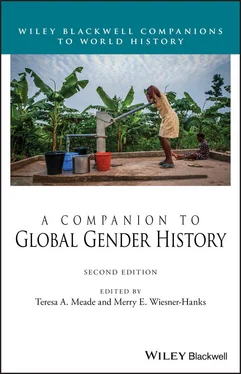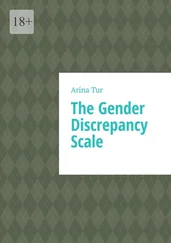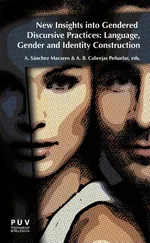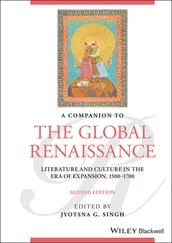Concepts of Women, Sex, and Gender
“Women” might at first glance have a more stable meaning than “race,” but here, too, bodily and cultural understandings have clashed and overlapped. In the 1980s, scholars in many fields began to differentiate between “sex,” by which they meant physical, morphological, and anatomical differences (what are often called “biological differences”), and “gender,” by which they meant a culturally constructed and historically changing system of differences. But just at the point that scholars were beginning to see the distinction between sex and gender (and an increasing number were accepting the importance of gender as a category of analysis), that distinction became contested. Not only were there great debates about where the line should be drawn – the age‐old debate of nature versus nurture – but some scholars wondered whether social gender and biological sex are so interrelated that any distinction between the two is meaningless. For example, although most people are categorized “male” or “female” at birth when someone looks at their external genitalia, some have more ambiguous sex organs. The gender polarity man/woman has been so strong, however, that such intersex persons were usually simply assigned to the sex they most closely resembled. Since the nineteenth century, surgical procedures, generally shortly after birth, have been used to modify or remove the body parts that did not fit. Thus, cultural norms about gender (that everyone should be a man or a woman) determine sex in such cases, rather than the other way around. Judith Butler argued in Gender Trouble that sex is not prior to gender; rather, sex “ought to be understood as an effect ” of cultural constructions of gender (1990: 6; emphasis added). Her theory suggests that “rather than being the expression of sex, or the cultural production of sex … gender, in fact, regulates the notion that sex is the natural condition of the human body” (177; emphasis added).
Trans individuals have challenged the arbitrary and culturally constructed nature of sex. In the 1950s, sex‐change operations became available for people whose external genitalia and even chromosomal and hormonal patterns marked them as male or female but who mentally understood themselves to be the other. Transsexual surgery could make the body fit more closely with the mind, but it also led to challenging questions about the role of the body and bodily processes in gender. Butler and others had emphasized the cultural construction of gender (and sex), but some theorists returned to the body as a key site of difference. Bernice L. Hausman, for example, sought “to show how transsexuals compromise the official understanding of ‘gender’ as divorced from biological sex by their insistent reiteration of the idea that physiological intersexuality is the cause of their cross‐sex identification” (1995: 141; emphasis added). Others downplayed the link between physiological intersexuality and trans identity, particularly as some individuals came to understand “trans” to mean not only moving from one gender to the other, but also as neither male nor female or both male and female or in some way outside a dichotomous gender system.
Individuals outside the dichotomous gender system are not something new, but have existed in many cultures in the past. Studies of third and trans genders in history are proving politically useful, as people within the LGBTQ+ (lesbian, gay, bisexual, trans, queer/questioning, plus) and trans movements today use them to demonstrate the variety in understandings of gender and sexuality, and to stress that demands for rights for homosexuals or third gender individuals are not simply a Western import. In this they looked to examples of third or even fourth and fifth genders around the world, such as what are now usually termed “two‐spirit people” among Native Americans, individuals who often had (and in some cases still have) special religious and ceremonial roles because they were regarded as having both a male and female spirit rather than the more common single spirit (Rifkin, 2011).
To questions about the category “woman” that come from intersex and trans individuals are those that come from other categories of difference. As feminist scholars put increasing emphasis on differences among women, Butler and others have wondered whether it made sense to talk about “women” at all (1990: 14). Similarly, Mohanty argues against the notion that women constitute a “coherent group with identical interests and desires regardless of class, ethnic or racial location, or contradictions” since that implies “a notion of gender or sexual difference, or even patriarchy, which can be applied universally and cross‐culturally” (2003: 55). The problem with this essentialist thinking is that women are constituted prior to entry into specific social, cultural, and historical contexts. Like race, women, sex, and gender are thus terms whose meanings are unstable and murky. Nonetheless, activists could argue that the contention that gender, or even “women,” are merely cultural constructs erases the very real oppression that many women experience. They have extended Higgenbotham’s idea of race as a discursive tool for liberation and Spivak’s of strategic essentialism to gender, recognizing that this is essential for understanding intersectional oppression, and using this knowledge as a basis for engaged scholarship or activism.
The Inseparable Nature of Race and Gender
The key insight of intersectionality is that no one identity or category of oppression should be considered apart from other identities, and although feminist theorists considered race and gender separately, they also increasingly considered them together. “By understanding how race is a gendered category, we can more systematically address the structural underpinnings of why women’s experiences differ so radically and how these differences are relationally constituted” (Liu, 1991: 269).
Many African American and Native American scholars draw attention to the ways race often operated historically to unify women and men in categories that divided women. After emancipation, black women, regardless of class, were denied entrance to train cars designated for women as a safe space. Feminist writer bell hooks (2000) asserts that during the Civil Rights movements in the United States, race unified black men and women, dividing women along color lines as white women sought to protect their privilege and dominance over black women. In examples such as these, Maynard argues, race “does not simply make women’s subordination greater; race makes it qualitatively different” (in Bhavnani, 2001: 125). Women in traditional Native American cultures, for example, often enjoyed gender equity not available to European women settlers in the dominant white culture who were subordinated within patriarchal hierarchies. The system was not without contestation. In pre‐Columbian Andean societies, women held considerable influence in religious practices and within a pantheon of deities, which was considered totally unacceptable to Catholic priests and Spanish conquerors. In each of these examples, race operates as a distinct category of analysis, but intersects with gender.
According to Tessie Liu, racial principles based on boundaries of lineage are necessarily closely linked to reproductive politics and control over women. Colonial rule was “contingent on the colonists’ ability to construct and enforce legal and social classifications for who was white and who was native , who counted as European and by what degree, which progeny were legitimate and which were not” (1991: 272). Particularly in Latin America, secular authority was always in conflict with the clergy, since the latter sought to sanctify marriage between “unequal” partners if the couple insisted or the woman was pregnant. For their part, parents and the colonial authorities viewed marriages that crossed lines of race, status, and class as a threat to “racial purity” and the consolidation of wealth in the hands of the elite.
Читать дальше












